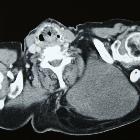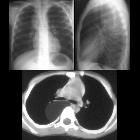lipoblastomatosis
Lipoblastomatosis is an uncommon presentation of a benign fatty neoplasm. The condition is more common in infants and young children. It differs from a lipoblastoma in that it is extensive and infiltrative.
Pathology
Lipoblastomatosis consists of immature adipose tissue surrounding myxomatous soft tissue. Similar to lipoblastoma, lipoblastomatosis tends to occur in the extremities.
Microscopic appearance
Characterized by groups of embryonal lipoblasts in a myxoid stroma, collected into lobular compartments, separated by fibrous tissue septa. Lipoblastoma and lipoblastomatosis are differentiated macroscopically and not differentiated histologically. The main histologic differential diagnosis is myxoid liposarcoma.
Radiographic features
Ultrasound
- homogeneous hyperechoic mass
CT
- well-defined soft tissue densities within large masses of low attenuation adipose tissue
MRI
- follows fat signal on all pulse sequences and suppresses on fat-saturated sequences
- T1: some streaky signal with equivalent intensity to muscle
Treatment and prognosis
Lipoblastoma and lipoblastomatosis have traditionally been treated with excision, although this practice has been called into question. There is a recurrence rate of up to 20% with no recorded case of metastasis. Some cases have matured into lipomas .
Siehe auch:

 Assoziationen und Differentialdiagnosen zu benign lipoblastomatosis:
Assoziationen und Differentialdiagnosen zu benign lipoblastomatosis:

